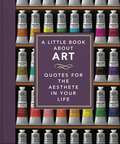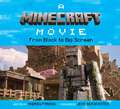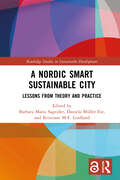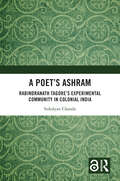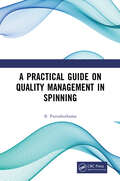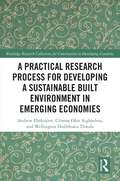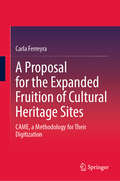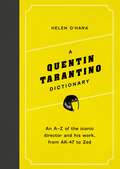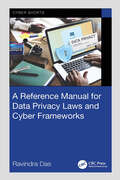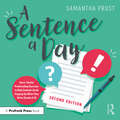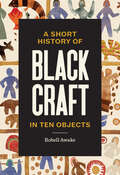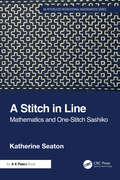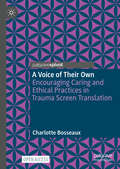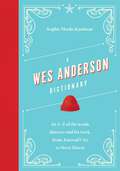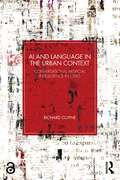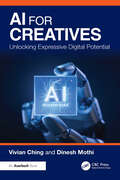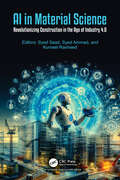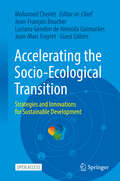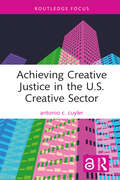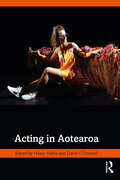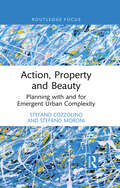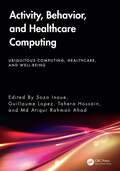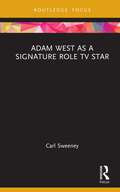- Table View
- List View
A Little Book About Art: Quotes for the Aesthete in Your Life
by Orange Hippo!"Art should comfort the disturbed and disturb the comfortable..." - Cesar A. CruzAcross the centuries, art has held up a mirror to humanity's evolving culture and creativity. Ancient civilizations left us mysterious sculptures while Renaissance artists produced iconic masterpieces. The Impressionists captured fleeting moments of beauty, while the Surrealists explored dreams and the subconscious. In recent decades, artists such as Frida Kahlo, Jackson Pollock and Banksy have embraced new mediums and pushed artistic boundaries even further.Brimming with fabulous quotes, this little book offers a window into the minds of some of the world's most admired artists and thinkers - and is a vibrant celebration of the evolution of art through the ages."Life is art. Art is life. I never separate it." - Ai Weiwei
A Minecraft Movie: From Block to Big Screen
by Andrew FaragoGo behind the scenes of A Minecraft Movie and experience the creative journey that transformed the biggest video game of all time into a big-screen block-buster.Break open the filmmaking secrets of A Minecraft Movie with this deluxe art book. Featuring commentary from the filmmakers, this volume explores how a team of world-class artists brought the iconic, limitless world of Minecraft to the big screen. Including insights from the creatives as well as stunning illustrations and visuals––such as never-before-seen concept art and photography––this book is the ultimate companion to the first ever live-action adaptation of Minecraft. NEVER-BEFORE-SEEN IMAGERY: From character, mob, and item designs to images of in-world Minecraft locations and stunning photography, this book offers an incredible gallery of visuals from A Minecraft Movie. INTERVIEWS WITH CREATORS: Immerse yourself in the world of Minecraft like never before with exclusive behind the scene insights from the game creators and filmmakers. MINE THE CREATIVE CRAFT: Follow the filmmaking process of adapting the biggest video game of all time via beautiful concept art, amazing photography, and more.
A Nordic Smart Sustainable City: Lessons from Theory and Practice (Routledge Studies in Sustainable Development)
by Barbara Maria SageidetThis book critically explores research and development on the smart sustainable city, emphasizing the tension and association between smartness and sustainability, both as a concept and as a phenomenon in a Nordic context.Worldwide, increasing urbanization and its related challenges, along with urgent environmental issues, have sped up the international interest for smart, sustainable cities as a concept that could increase the efficiency of services, minimize environmental impacts, and improve the quality of living in cities and urban areas. This book scientifically discusses the provenance, substance, and processes of the smart sustainable city, with illustrative examples of how it is translated into urban realities in a medium-sized city, drawing upon Stavanger, one of the first, and one of the leading smart sustainable cities in Europe. The book’s multidisciplinary perspectives and thematic lenses include education and knowledge, arts and culture, safety, climate and sustainability, mobility and transport, economics, democracy, participation, innovation and entrepreneurship, data, and communication. While demonstrating the academic breadth and wide-ranging impact of the smart sustainable city concept, the book promotes and updates the ground for mutual understanding, communication, and collaboration between multiple disciplines and stakeholders involved in developing functional, democratic, and sustainable solutions for the urban present and future.A Nordic Smart Sustainable City: Lessons from Theory and Practice presents an overview of scientific and practical current approaches in a readable format for practitioners and administrators in municipalities and related businesses, for researchers, academics, educators, students, and stakeholders.
A Poet’s Ashram: Rabindranath Tagore’s Experimental Community in Colonial India
by Sukalyan ChandaThe remarkably creative life Rabindranath Tagore (1861–1941) lived has long been an area of scholarly enquiry. Yet, surprisingly, his role as the founder of an experimental ashram community remains unexplored. A Poet’s Ashram retrieves his idea of his ashram through an exploration of his writings on the institutions he built.The ashram community Tagore endeavoured to create in Santiniketan during the period 1901–1941 was his response to the question of modernity. Through his effort to reinvent the ancient Indian ideal of the ashram, he articulated his idea of a mode of collective living that was meant to be grounded in a set of ethical values derived from India’s civilizational inheritance. This book traces the history of how his ashram school evolved into a community that practised egalitarianism, inclusiveness and creativity through its daily existence. It explores a range of nineteenth- and twentieth-century discourses and Tagore’s engagement with them in order to situate that idea within its historical context, a critical juncture in the history of modern India and the world. This book’s reading of his project unravels its anti-colonial underpinnings and the commonalities it shared with some of the other similar experimental communities that challenged illiberal ideologies and power relations during the early twentieth century.Meticulously researched and perceptively written, this book will be of interest to students and researchers of history, political science, culture studies and postcolonial studies. It will also be of interest to educationists, educators and those interested in colonial modernity, modern Indian history, philosophy of education, institution building, peace, inclusivity and sustainability.
A Practical Guide on Quality Management in Spinning
by B. PurushothamaThis book is a hands-on guide that discusses quality management in spinning. It details the techniques, insights and best practices that weave excellence into every fiber. The subject matter of this book discusses the concepts of product objectives and the impact of product features at customer’s end with examples.Print edition not for sale in South Asia (India, Sri Lanka, Nepal, Bangladesh, Pakistan and Bhutan)
A Practical Research Process for Developing a Sustainable Built Environment in Emerging Economies (Routledge Research Collections for Construction in Developing Countries)
by Andrew Ebekozien Clinton Ohis Aigbavboa Wellington Didibhuku ThwalaA Practical Research Process for Developing a Sustainable Built Environment in Emerging Economies aims to fill the dearth of practical research guidance and reference material with specific focus on the built environment in developing countries. Global policy agendas such as Agenda 2030 (the SDGs) highlight the importance and growth of research and knowledge from emerging nations who are increasingly contributing to research that is critical for development and advancement. The role of built environment practitioners will continue to evolve by building on the sound foundations laid down by the professions and by exploiting to the full the new technologies available to us through conducting innovative research, but more guidance on the research process is necessary to ensure the integrity and quality of the output.This book has been structured so that each chapter is largely free-standing, allowing the reader (undergraduate, postgraduate, or practitioner) to reference the material with ease. It aims to provide practical guidance on conducting research and on writing a dissertation or report and begins by considering the general research background in a built environment context. It then covers research ethics, before moving on to discuss the importance of selecting the right research topic and title and writing a clear abstract. The chapters then cover introducing a research project, and the authors include a section on the problem statement, research questions, aims and objectives, research gap(s), and motivations for the study. The book goes on to cover the literature review section, theoretical and conceptual frameworks, the various types of methodological approaches, and when to apply them. The findings section, discussion of the results, and the study’s implications are then discussed, before the final chapters cover the conclusion and recommendations.The book provides a useful reference for higher education students, graduates, postgraduates, and practitioners engaged in all aspects of construction and built environment research.
A Proposal for the Expanded Fruition of Cultural Heritage Sites: CAME, a Methodology for Their Digitization
by Carla FerreyraThis book presents a comprehensive methodology, integrating analysis, digitization, and the preservation of cultural heritage. It investigates three potential UNESCO World Heritage Sites, in Italy, Germany and South Africa, and employs a blend of documentary research and advanced digital surveying and data processing techniques. The volume shows how these efforts yielded actionable strategies to meet society's evolving demands for surveying, recovery, and conservation. The book documents the work behind the overarching objective which was to digitize, analyze, categorize, and store all collected data within a BIM framework, with the aim of streamlining collaboration, enhancing management efficiency, and optimizing processes. It demonstrates the utilization of digital tools in not only amplifying traditional scientific-technological approaches to heritage protection, but also its role in reshaping the perception, comprehension, and communication of heritage. This fosters the development of more sustainable conservation strategies.
A Quentin Tarantino Dictionary: An A–Z of the iconic director and his work, from AK-47 to Zed (Director Dictionaries)
by Helen O'HaraExplore an A-Z of everything you need to know about the masterful movies of Quentin Tarantino, from AK-47 to "Zed's dead, baby" and everything in between.With hundreds of entries covering every facet of Tarantino's work - from inspiration and influences to his most frequent collaborators and little-known cameos - A Quentin Tarantino Dictionary is a stylish guide to the wonderful world of this visionary filmmaker.Written by author and film critic Helen O'Hara (Empire, BAFTA, the Telegraph) and with bespoke illustrations that bring the director's vision to life, this is a one-stop shop for all things Tarantino.
A Quentin Tarantino Dictionary: An A–Z of the iconic director and his work, from AK-47 to Zed (Director Dictionaries)
by Helen O'HaraExplore an A-Z of everything you need to know about the masterful movies of Quentin Tarantino, from AK-47 to "Zed's dead, baby" and everything in between.With hundreds of entries covering every facet of Tarantino's work - from inspiration and influences to his most frequent collaborators and little-known cameos - A Quentin Tarantino Dictionary is a stylish guide to the wonderful world of this visionary filmmaker.Written by author and film critic Helen O'Hara (Empire, BAFTA, the Telegraph) and with bespoke illustrations that bring the director's vision to life, this is a one-stop shop for all things Tarantino.
A Reference Manual for Data Privacy Laws and Cyber Frameworks (Cyber Shorts)
by Ravindra DasAs the world is becoming more digital and entwined together, the cybersecurity threat landscape has no doubt become a daunting one. For example, typical threat variants of the past, especially those of phishing, have now become much more sophisticated and covert in nature. A lot of this has been brought on by the proliferation of ransomware, which exploded during the COVID-19 pandemic. Now, there is another concern that is looming on the horizon: data privacy. Now, more than ever, consumers on a global basis want to know exactly what is happening to their personal identifiable information (PII) datasets. Examples of what they want to know about include the following: What kinds and types of information and data are being collected about them How those PII datasets are being stored, processed, and transacted with How their PII datasets are being used by third-party suppliers In response to these concerns and fears, as well as the cyber risks posed by these datasets, many nations around the world have set up rather extensive and very detailed data privacy laws. In their respective tenets and provisions, these pieces of legislation not only specify why and how businesses need to comply with them, but also outline the rights that are afforded to each and every consumer. In this book, we detail the tenets and provisions of three key data privacy laws: The GDPR The CCPA The CMMC We also provide a general framework at the end on how a business can comply with these various data privacy laws.The book begins with an in-depth overview of the importance of data and datasets, and how they are so relevant to the data privacy laws just mentioned.
A Sentence a Day: Short, Playful Proofreading Exercises to Help Students Avoid Tripping Up When They Write (Grades 6-9)
by Samantha PrustA Sentence a Day is not your average grammar workbook. Focusing on short, playful, interesting sentences with a sense of humor, these proofreading exercises help students learn without feeling overwhelmed.This new edition features 50 new exercises and interactive elements in its ebook+ version! Each exercise should take only a few minutes of class time, allowing for frequent, consistent reinforcement and practice of serious writing skills. Each exercise shows an incorrect sentence, a sample correction, and explanatory notes for the teacher.With a wide range of difficulty throughout the lessons, this book is a great resource for middle school students, high school students, or anyone looking to improve their writing and grammar skills.
A Short History of Black Craft in Ten Objects
by Robell AwakeTen beautifully illustrated essays tell the stories of handcrafted objects and their makers, providing inspiration and insight into Black history and craftsmanship.Black artisans have long been central to American art and design, creating innovative and highly desired work against immense odds. Atlanta-based chairmaker and scholar Robell Awake explores the stories behind ten cornerstones of Black craft, including:The celebrated wooden chairs of Richard Poynor, an enslaved craftsman who began a dynasty of Tennessee chairmakers.The elegant wrought-iron gates of Philip Simmons, seen to this day throughout Charleston, South Carolina, whose work features motifs from the Low Country.The inventive assemblage art and yard shows of Joe Minter, James Hampton, Bessie Harvey, and others, who draw on African spiritual traditions to create large-scale improvisational art installations.From the enslaved potters of Old Edgefield, South Carolina, to Ann Lowe, the couture dressmaker who made Jacqueline Kennedy's wedding dress, to Gullah Geechee sweetgrass basket makers, to the celebrated quilters of Gee's Bend, A Short History of Black Craft in Ten Objects illuminates the work of generations of Black craftspeople, foregrounding their enduring contributions to American craft.BLACK CRAFT AND AMERICANA: Delving into the history of Black skilled artisans, estimated to have outnumbered white artisans five to one in the southern United States in the late 1800s, this unique art history book celebrates handcrafted objects that reflect the dynamic nature of Black culture.DYNAMIC ILLUSTRATED ESSAYS: Luminous color illustrations by artist Johnalynn Holland highlight beloved craft objects and their makers, creating a fascinating volume to study and treasure.ART HISTORY EXPERTISE: Author Robell Awake is a notable furniture maker, artisan, and educator whose work has been featured in the New York Times and in group shows at Verso Gallery in New York City and the Center for Craft in Asheville, NC. Dr. Tiffany Momon, who contributes an afterword, is the founder and co-director of the Black Craftspeople Digital Archive and a leading scholar of Black history and African American placemaking throughout the southeast.BEAUTIFUL GIFT BOOK: The gorgeous design is ideal for art collectors and craft enthusiasts, as a keepsake reminder of Black heritage, for Black History Month and beyond.Perfect for:Anyone interested in the intersection of Black art, craft, and historyDesigners and craftspeopleEducators and studentsCollectors and museum curatorsLovers of fine and artisanal design objects
A Stitch in Line: Mathematics and One-Stitch Sashiko (AK Peters/CRC Recreational Mathematics Series)
by Katherine SeatonA Stitch in Line: Mathematics and One-Stitch Sashiko provides readers with instructions for creating hitomezashi items with minimum outlay. The reader is guided through the practical steps involved in creating each design, and then the mathematics which underpins it is explained in a friendly, accessible way. This is a fantastic book for anyone who is interested in recreational mathematics and/or fibre arts and can be a useful resource for teaching and learning mathematical concepts in a fun and engaging format. Features Numerous full-colour photographs of hitomezashi stitch patterns which have been mathematically designed. Suitable for readers of all mathematical levels and backgrounds — no prior knowledge is automatically assumed. A compressed encoding for recording and designing hitomezashi patterns to be stitched or drawn. Accessible explanations and explorations of mathematical concepts inherent in, or illustrated by, hitomezashi patterns.
A Voice of Their Own: Encouraging Caring and Ethical Practices in Trauma Screen Translation
by Charlotte BosseauxThis open access book explores which audiovisual translation methods or techniques are the most ethical when translating personal narratives dealing with trauma and emotions, and provides good practice guidelines for different stakeholders (audiovisual translators, Language Service Providers, charities, survivors and filmmakers) to ensure that the voices of those who have suffered from trauma and Gender-Based Violence are ethically conveyed on-screen. It also shows how subtitlers cope with the translation of challenging sensitive material. The work described in this book is based on Prof Bosseaux&’s Ethical Translation project and is underpinned by a practical component: a multilingual documentary featuring women who have gone through traumatic events and whose first language is not English. Above all, the research emphasises the importance of filming and translating ethically with a focus on making sure survivors and audiovisual translators&’ voices are fully heard through respectful translation. This book showcases the theories and methods used and developed throughout the Ethical Translation project and the results of the research conducted, ultimately demonstrating the importance of carrying out practice-based research and encouraging collaboration between academics, practitioners and stakeholders to produce research that can be of use to, and be applied by, these groups.
A Wes Anderson Dictionary: An A–Z of the iconic director and his work, from Asteroid City to Steve Zissou (Director Dictionaries)
by Sophie Monks KaufmanExplore an A-Z of everything you need to know about the iconic films of Wes Anderson, from Asteroid City to Steve Zissou and everything in between.With hundreds of entries covering every facet of Anderson's work - from inspiration and influences to his most frequent collaborators and little-known quirks - A Wes Anderson Dictionary is a stylish guide to the wonderful world of this iconic, unique filmmaker.Written by author and journalist Sophie Monks Kaufman (Little White Lies, Empire, Netflix, BBC) and with bespoke illustrations that bring the director's vision to life, this is a one-stop shop for all things Anderson.
A Wes Anderson Dictionary: An A–Z of the iconic director and his work, from Asteroid City to Steve Zissou (Director Dictionaries)
by Sophie Monks KaufmanExplore an A-Z of everything you need to know about the iconic films of Wes Anderson, from Asteroid City to Steve Zissou and everything in between.With hundreds of entries covering every facet of Anderson's work - from inspiration and influences to his most frequent collaborators and little-known quirks - A Wes Anderson Dictionary is a stylish guide to the wonderful world of this iconic, unique filmmaker.Written by author and journalist Sophie Monks Kaufman (Little White Lies, Empire, Netflix, BBC) and with bespoke illustrations that bring the director's vision to life, this is a one-stop shop for all things Anderson.
AI and Language in the Urban Context: Conversational Artificial Intelligence in Cities
by Richard CoyneIn a world influenced increasingly by artificial intelligence (AI), the city emerges as a dynamic hub of digital conversations. AI and Language in the Urban Context offers a novel exploration of how AI, particularly large language models (LLMs), is transforming urban environments. Moving beyond the typical technological narratives, this book draws on the author’s unique expertise in design, semiotics and hermeneutics to present a critical cultural perspective on AI’s role in the city.Focusing on the intersection of urban theory and AI, the book reveals how conversational AI is reshaping social interactions, decision-making processes, and media in urban spaces. By merging practical knowledge of AI algorithms with an understanding of urban practices, the author highlights the opportunities and challenges AI presents for modern cities.This book is essential for anyone interested in the future of urban living. It provides a deep dive into the technical, social and cultural implications of AI in cities, offering practical examples and philosophical insights. Readers will gain a comprehensive understanding of how AI is influencing the design, governance and dynamics of urban life in the digital age.The Open Access version of this book, available at www.taylorfrancis.com, has been made available under a Creative Commons [Attribution-Non Commercial-No Derivatives (CC-BY-NC-ND) 4.0 license.
AI for Creatives: Unlocking Expressive Digital Potential
by Vivian Ching Dinesh MothiAI for Creatives: Unlocking Expressive Digital Potential takes you on a dynamic journey into the future of creativity, where AI is reshaping how creators approach their craft. According to a 2023 UNESCO report, the global creative industries are valued at an astounding USD 4.3 trillion annually, employing nearly 30 million people worldwide. This essential guide empowers professionals across visual arts, music, writing, film, fashion, and design to leverage the transformative potential of AI to elevate their work in ways previously unimaginable.Designed as a practical handbook for creative professionals, this book provides a clear and approachable road map for integrating AI into your work, regardless of prior experience. Packed with real-world case studies, step-by-step walk-throughs, and insights into AI-driven tools, like RunwayML, Midjourney, Canva, and ChatGPT, the book demonstrates how AI can supercharge creative processes. Whether you are a filmmaker using AI for hyper-realistic visuals or a fashion designer predicting fabric trends, this guide offers the tools to unlock your full creative potential.The book also dives into the deeper ethical and legal questions that emerge as machines increasingly enter the creative arena. How do we strike the right balance between human ingenuity and machine-driven creativity? What happens to intellectual property rights when AI becomes a co-creator? This book tackles these pressing issues head-on, from navigating bias in AI algorithms to safeguarding the authenticity of creative works, while also exploring the role of education in navigating these challenges. With actionable insights, creative professionals will learn to embrace AI while preserving the integrity, originality, and values that define their craft.AI is not just changing how we create but also disrupting the future of employment and economic growth across the globe. With the demand for creative roles projected to surge by 30–40% by 2030, it is evermore critical to harness the power of AI to stay ahead, innovate faster, and meet the growing need for creative solutions across industries. Are you ready to explore the future of creativity and amplify your vision? Step into the next era of AI transformation with this essential guide—your creative revolution starts now.
AI in Material Science: Revolutionizing Construction in the Age of Industry 4.0
by Syed Saad Syed Ammad Kumeel RasheedThis book explores the transformative impact of artificial intelligence on material science and construction practices in the Industry 4.0 landscape. It enquires into AI history and applications, examining material optimization, smart materials, and AI in construction. Covering automation, robotics, and AI-assisted design, the book provides insights into ethical considerations and future trends. A modern reference for scholars and professionals, it bridges academia and practical applications in the dynamic intersection of AI and materials science.
Accelerating the Socio-Ecological Transition: Strategies and Innovations for Sustainable Development
by Mohamed Cheriet Jean-François Boucher Luciana Gondim de Almeida Guimarães Jean-Marc FrayretThis book explores the key principles and challenges of implementing the socio-ecological transition, with a particular focus on Quebec, Canada. It addresses these issues from both research and educational perspectives, offering actionable strategies to accelerate this transition across the province's various economic sectors. The book's structure aligns with the CIRODD (Interdisciplinary Research Center for Operationalization of Sustainable Development) scientific program, organized into two major sections and 11 thematic areas. The objective is to showcase the latest advancements in socio-ecological transition, drawing on a decade of research contributions from CIRODD. This book edition will highlight key innovations, emerging trends, and impactful solutions that have shaped the field, demonstrating CIRODD&’s pivotal role in driving sustainable transformation. Section 1 delves into practical interventions and strategies for citizen engagement, exploring transition initiatives, urban planning, and collaborative knowledge-building models. It brings together theoretical, practical, and experiential insights, emphasizing the vital role of research and the arts in facilitating the socio-ecological transition. Section 2 equips readers with the necessary tools to support this transition, offering models and methods for analyzing complex systems. It highlights innovative digital approaches for developing circular and sustainable business models. This is an open access book.
Achieving Creative Justice in the U.S. Creative Sector (Routledge Focus on the Global Creative Economy)
by antonio c. cuylerCaste and the discrimination, exclusion, marginalization, othering, oppression, subalterning, and subjugation that it produces continue to challenge creative industries compromising culture’s verisimilitude as a public good. Achieving Creative Justice in the U.S. Creative Sector explores the relationships between access, diversity, equity, and inclusion (ADEI), and creative justice in the U.S. creative sector as a solution to meaningfully address enduring creative injustices.Whether it’s the #BlackLivesMatter, #LandBack, or #MeToo movements, caste remains structurally and systemically built into U.S. Society, and thereby the creative sector. Acknowledging this realization after George Floyd’s murder in 2020 has galvanized a quest for solutions. This book encourages sincere consideration for the human toll of insisting on artistic excellence and artistic merit at the expense of profound and unnecessary identity-based human suffering.Providing a practical guide on how to activate ADEI to achieve creative justice and a research agenda, this book is an essential reading for practitioners and scholars who feel compelled to address creative injustices that constrain the creative flourishing of historically and continuously low-casted peoples throughout the entire cultural ecosystem that defines the U.S. creative sector.The Open Access version of this book, available at http://www.taylorfrancis.com, has been made available under a Creative Commons [Attribution-Non Commercial-No Derivatives (CC BY-NC-ND)] 4.0 license.
Acting in Aotearoa
by Hilary Halba David O’DonnellThis comprehensive text traces a cultural history of acting practice in Aotearoa/New Zealand, whose Indigenous Māori practitioners have made a significant impact on acting processes, principles and values in this postcolonial nation.Each chapter outlines not only historical aspects of acting in Aotearoa but also the way in which the phenomenon of acting has been modified by contingent local conditions. Interwoven into each chapter is a consideration of cultural, political and historical forces that have influenced the art form of acting in Aotearoa. Chapters include vivid personal accounts from the contributors, all of whom are also professional artists as well as scholarly experts in their fields. Interweaving the chapters are interviews with key practitioners and actors, which provide eloquent, first-hand accounts of current innovative actor training practice.Representing a wide range of approaches to acting and actor training for stage and screen, this book will be of use to scholars, students and theatre practitioners alike.
Action, Property and Beauty: Planning with and for Emergent Urban Complexity
by Stefano Moroni Stefano CozzolinoWhat are the challenges and potential of complex and emergent urban systems? This book answers this question by shedding new light on the topics of emergence, complexity, and self-organisation and showing their interconnectedness with other concepts, such as property and beauty, which are usually considered separately. It contributes to the discussion by interpreting and explaining the nature of emergent urban phenomena and suggesting more appropriate design and planning measures.The book explores and untangles these crucial topics in a compact and accessible way by offering fresh interdisciplinary perspectives on the themes of action and interaction, self-organisation, property, neighbourhood adaptability, urban beauty, and suitable public planning and design interventions. It provides novel and crucial insights for students, researchers, and academics in Urban Studies, Planning Theory, Planning Ethics, Planning Law, Legal, Political and Human Geography, Urban and Regional Economics, Urban Sociology, and Urban Design. It is essential for anyone interested in exploring the emergent dynamics of complex urban contexts, as well as for those involved in developing various projects and measures who aim to consider the spontaneous nature of cities seriously.
Activity, Behavior, and Healthcare Computing (Ubiquitous Computing, Healthcare and Well-being)
by Guillaume Lopez Sozo Inoue Tahera Hossain Rahman Ahad, Md AtiqurActivity, Behavior, and Healthcare Computing relates to the fields of vision and sensor-based human action or activity and behavior analysis and recognition. As well as a series of methodologies, the book includes original methods, exploration of new applications, excellent survey papers, presentations on relevant datasets, challenging applications, ideas and future scopes with guidelines. Featuring contributions from top experts and top research groups globally related to this domain, the book covers action recognition, action understanding, gait analysis, gesture recognition, behavior analysis, emotion and affective computing, healthcare, dementia, nursing, Parkinson’s disease, and related areas. It addresses various challenges and aspects of human activity recognition – both in sensor-based and vision-based domains. This is a unique edited book covering both domains in the field of activity and behavior.
Adam West as a Signature Role TV Star (Routledge Focus on Television Studies)
by Carl SweeneyThis book proposes the ‘signature role TV star’ as a new theoretical category of stardom by evaluating Adam West as a quintessential example of this type of figure.West was best known for playing the titular role in the 1960s television series Batman. After Batman was cancelled, West was unable to develop a lasting career as a mainstream leading man, meaning that his signature role remained the defining aspect of his public image. In various ways, West demonstrated that the strong link with a signature televisual role can generate new inflections over time, meaning that he embodies both the advantages and disadvantages of this form of stardom. The analysis of West as an archetypal signature role TV star is accomplished within a star studies theoretical framework that focuses on his onscreen roles, his promotional and publicity appearances and criticism and commentary materials about him. The signature role TV star category proposed in this book can be utilised to illuminate the significance of other television stars who have been overlooked by scholars.This book will have relevance for undergraduate and postgraduate students of Film Studies, Television Studies, Media and Communication Studies, Cultural Studies, Visual Studies and Comics Studies.
